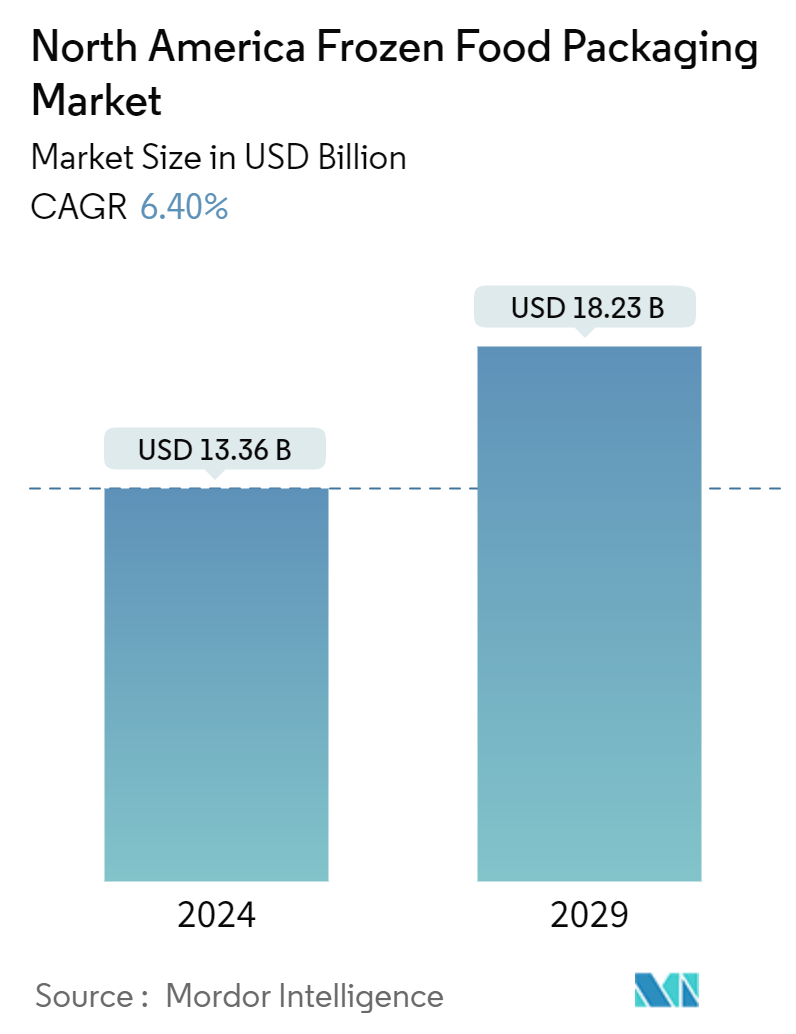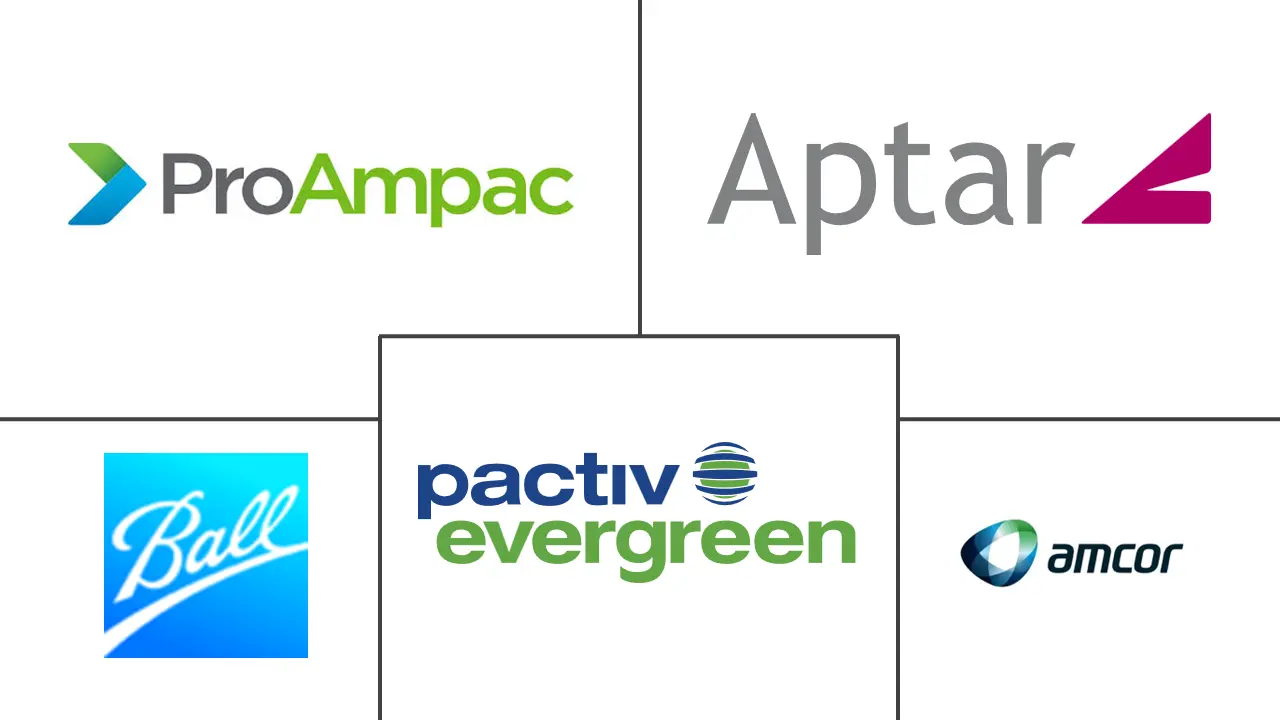Market Size of North America Frozen Food Packaging Industry

| Study Period | 2019 - 2029 |
| Base Year For Estimation | 2023 |
| Market Size (2024) | USD 13.36 Billion |
| Market Size (2029) | USD 18.23 Billion |
| CAGR (2024 - 2029) | 6.40 % |
| Market Concentration | Medium |
Major Players
*Disclaimer: Major Players sorted in no particular order |
North America Frozen Food Packaging Market Analysis
The North America Frozen Food Packaging Market size is estimated at USD 13.36 billion in 2024, and is expected to reach USD 18.23 billion by 2029, growing at a CAGR of 6.40% during the forecast period (2024-2029).
- With frozen items requiring less time and effort than traditional home-cooked meals, the rising consumer demand for convenience is fueling the growth of frozen product sales. Busy lifestyles are pushing consumers toward processed foods, leading to a surge in demand for frozen food. The primary categories of packaged frozen foods include bakery products and frozen processed foods, with frozen ready-to-eat items emerging as a notable category. Colder storage temperatures can significantly extend shelf life, all while consumer expectations for food quality continue to rise.
- As consumers increasingly turn to frozen foods, there is a growing demand for sustainable packaging materials. Numerous manufacturers and retailers are transitioning from traditional packaging to recyclable, reusable, and compostable alternatives. This surge in demand for frozen foods and individually wrapped items has the packaging industry racing to adapt. Innovations in frozen food packaging are on the rise, with notable advancements like steamable packaging for microwavable products. Furthermore, developments in cold-chain technology and smart packaging, like alerting users to temperature changes, are expected to address these evolving needs.
- Grocery shopping habits have undergone a seismic shift. A growing number of consumers are turning to online platforms for their food purchases, prioritizing convenience and safety. In response to these evolving preferences, retailers are diversifying their order fulfillment methods. These include competitive pricing, curbside pickups, home deliveries, food delivery apps, and pickups from remote locations.
- As retailers strive to enhance their recall value and presence in rural, tier I, and tier II regions, they are intensifying efforts to make their promotional programs more enticing. This dynamic not only underscores the evolving landscape of grocery retailing but also highlights the burgeoning opportunities that are shaping the demand for frozen foods in these regions.
North America Frozen Food Packaging Industry Segmentation
Frozen food packaging helps preserve food from the time it is prepared to when it is eaten. Frozen food packaging helps maintain original color, flavor, and texture, and generally, more nutrients than foods preserved by other methods. Mostly fruits and vegetables, meat and seafood, frozen desserts and ice creams, and baked goods are packaged in bags, boxes, tubs, cups, trays, wrappers, and pouches.
The North American frozen food packaging market is segmented by packaging material (glass, paper, metal, plastic, and other packaging materials), food product (readymade meals, fruits and vegetables, meat, seafood, baked goods, and other food products), packaging product (bags, boxes, cans, cartons, trays, wrappers, and other packaging products), and country (United States and Canada). The report offers market sizes and forecasts in value (USD) for the above segments.
| By Material | |
| Glass | |
| Paper | |
| Metal | |
| Plastic | |
| Other Materials |
| By Food Product | |
| Readymade Meals | |
| Fruits and Vegetables | |
| Meat and Poultry | |
| Seafood | |
| Baked Goods | |
| Other Food Products |
| By Packaging Product | |
| Bags | |
| Boxes | |
| Cans | |
| Cartons | |
| Trays | |
| Wrappers | |
| Other Packaging Products |
| By Country | |
| United States | |
| Canada |
North America Frozen Food Packaging Market Size Summary
The North American frozen food packaging market is experiencing significant growth, driven by the increasing consumer demand for convenience meals and the evolving grocery shopping habits. As busy lifestyles become the norm, the preference for frozen foods, which require less preparation time, is on the rise. This trend is further amplified by the shift towards online grocery shopping, where consumers seek convenient and safe food options. Retailers are adapting by offering various order fulfillment methods, such as home delivery and curbside pickup, to cater to this demand. The market is also witnessing innovation in frozen food products, including plant-based and immunity-boosting options, which appeal to a diverse consumer base. The COVID-19 pandemic has further accelerated this trend, with frozen foods becoming a popular choice for meals, thereby boosting the demand for effective packaging solutions.
The market for frozen food packaging in North America is also influenced by the growth of e-commerce and the need for portable packaging solutions. As more consumers shop online, the demand for packaging that can securely transport food items through complex distribution channels is increasing. This has led to a rise in the use of flexible bags and other convenient packaging forms. The retail landscape in the United States is highly competitive, with major players like Walmart and Kroger driving market growth. Additionally, the demand for frozen food packaging is largely driven by millennials, who prefer single-serving and on-the-go food options. Key industry players are investing in product innovation to meet these demands, with recent developments focusing on sustainable and eco-friendly packaging solutions.
North America Frozen Food Packaging Market Size - Table of Contents
-
1. MARKET INSIGHTS
-
1.1 Market Overview
-
1.2 Industry Value Chain Analysis
-
1.3 Industry Attractiveness - Porter's Five Force Analysis
-
1.3.1 Threat of New Entrants
-
1.3.2 Bargaining Power of Buyers
-
1.3.3 Bargaining Power of Suppliers
-
1.3.4 Threat of Substitute Products
-
1.3.5 Intensity of Competitive Rivalry
-
-
1.4 Analysis of Geopolitical Scenario on the Industry
-
-
2. MARKET SEGMENTATION
-
2.1 By Material
-
2.1.1 Glass
-
2.1.2 Paper
-
2.1.3 Metal
-
2.1.4 Plastic
-
2.1.5 Other Materials
-
-
2.2 By Food Product
-
2.2.1 Readymade Meals
-
2.2.2 Fruits and Vegetables
-
2.2.3 Meat and Poultry
-
2.2.4 Seafood
-
2.2.5 Baked Goods
-
2.2.6 Other Food Products
-
-
2.3 By Packaging Product
-
2.3.1 Bags
-
2.3.2 Boxes
-
2.3.3 Cans
-
2.3.4 Cartons
-
2.3.5 Trays
-
2.3.6 Wrappers
-
2.3.7 Other Packaging Products
-
-
2.4 By Country
-
2.4.1 United States
-
2.4.2 Canada
-
-
North America Frozen Food Packaging Market Size FAQs
How big is the North America Frozen Food Packaging Market?
The North America Frozen Food Packaging Market size is expected to reach USD 13.36 billion in 2024 and grow at a CAGR of 6.40% to reach USD 18.23 billion by 2029.
What is the current North America Frozen Food Packaging Market size?
In 2024, the North America Frozen Food Packaging Market size is expected to reach USD 13.36 billion.

